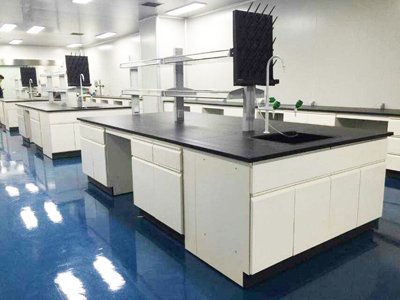In modern laboratories, solid chemical board countertops are the foundation of efficient, safe, and long-lasting workspace performance. These countertops are designed to meet the demanding conditions of chemical research, requiring exceptional corrosion resistance, fire resistance, moisture resistance, and mechanical durability. However, while compact solid chemical boards are widely used, they come with specific limitations and maintenance requirements that must not be overlooked. Understanding their characteristics, properties, and usage precautions is essential to ensure the longevity and reliability of laboratory surfaces.

Understanding Solid Chemical Board Countertops
A solid chemical board, often referred to as compact laminate board, is a high-pressure laminate (HPL) material made by compressing multiple layers of decorative paper, kraft paper, and phenolic resin under high temperature and pressure. The resulting product is a dense, non-porous panel with superior resistance to a variety of environmental and chemical stressors.
However, the composition and structure of compact boards determine their performance limits. While they perform well in general-purpose labs, they may not fully meet the stringent requirements of specialized chemical or biological laboratories where high-temperature and highly corrosive reactions frequently occur.
Key Characteristics of Solid Chemical Board Countertops
1. Structural Composition and Material Strength
Solid chemical boards are composed of:
Surface overlay paper: Provides the top finish and design aesthetics.
Decorative color paper: Adds visual appearance and identity to the surface.
Kraft paper layers or plant fiber layers: Offer structural rigidity and thickness.
Phenolic resin impregnation: Acts as the binding medium that ensures stability and moisture resistance.
The layers are fused under heat and pressure, creating a rigid, homogeneous material that is impact-resistant, smooth, and easy to clean. Despite these advantages, the phenolic resin core is not entirely resistant to all laboratory conditions—especially under prolonged exposure to heat and certain chemical reagents.
2. Temperature Resistance and Thermal Stability
While compact board countertops exhibit moderate heat resistance, their tolerance typically caps at 135°C. Beyond this temperature, the surface may experience:
These thermal reactions can also lead to loss of corrosion resistance and reduced mechanical integrity, compromising safety and appearance. Therefore, compact chemical boards should never be used in areas involving open flames, autoclaves, or direct heat exposure.
3. Surface Corrosion Resistance and Chemical Tolerance
Compact boards are manufactured with a 2µm-thick corrosion-resistant film composed of organic material. This thin protective coating shields the surface from a wide range of chemical reagents used in laboratories. However, it is not invincible.
Highly corrosive substances such as:
65% Nitric Acid
98% Sulfuric Acid
60% Chromic Acid
48% Hydrofluoric Acid
Phenol-based compounds
can gradually degrade or destroy the film, leading to irreversible damage. As a result, compact chemical boards are unsuitable for laboratories handling highly aggressive reagents or concentrated acid experiments.

4. Aging and Longevity of the Corrosion-Resistant Film
Under typical indoor laboratory conditions, the anti-corrosion film lifespan ranges from 3 to 8 years, depending on usage frequency and environmental exposure. Factors that accelerate aging include:
Continuous exposure to UV radiation can significantly shorten the film’s durability, resulting in discoloration, surface cracking, and decreased chemical resistance. To extend the lifespan, laboratories should maintain controlled environments and implement proper maintenance schedules.
5. Scratch Resistance and Surface Repairability
A major limitation of solid chemical boards is their inability to be repaired once damaged. Even minor scratches can compromise the protective surface, reducing both corrosion resistance and aesthetic quality. Unlike stone or epoxy resin countertops, surface refinishing or polishing is not possible.
It is recommended to:
Use protective mats or trays under heavy apparatus.
Avoid dragging sharp metal tools or glassware across the surface.
Immediately clean any abrasive residues to prevent micro-scratches.
6. Moisture Absorption and Dimensional Stability
Despite being considered water-resistant, compact boards have a surface water absorption rate of up to 0.71%. This moisture penetration, over time, can lead to:
In high-humidity environments, the board can absorb airborne moisture, especially around edges and cut sections. To mitigate this, edge sealing and silicone caulking are essential during installation.
7. Environmental and Health Considerations
The phenolic resin used in manufacturing compact chemical boards can release trace amounts of formaldehyde and volatile organic compounds (VOCs). Although most high-quality brands comply with environmental safety standards, poorly produced boards may emit higher levels of harmful substances.
During laboratory experiments involving heat or chemical reactions, these emissions may intensify, posing health risks to operators. Therefore, it is advisable to:
Choose certified low-emission products.
Maintain adequate ventilation within the lab.
Avoid prolonged exposure near heat-generating equipment.
8. Maintenance and Cleaning Recommendations
Proper cleaning and maintenance directly influence the service life of solid chemical board countertops. Here are key practices:
Use neutral cleaning agents instead of acidic or alkaline solutions.
Avoid abrasive scrubbing pads that can scratch the protective layer.
Wipe spills immediately to prevent chemical etching or discoloration.
Perform routine inspections for surface defects and promptly replace damaged sections.
Protect from prolonged exposure to UV light to prevent aging.

Precautions for Using Compact Board Countertops
To ensure safety and durability, consider the following essential precautions:
Avoid placing hot objects directly on the surface; always use heat pads.
Do not conduct acid digestion or high-temperature reactions directly on compact boards.
Install proper sealing around joints, edges, and sink areas to prevent water ingress.
Do not expose surfaces to direct sunlight or UV lamps for prolonged periods.
Handle all chemicals with care—wipe off spills immediately using soft, damp cloths.
Ensure proper air circulation in laboratories to prevent moisture buildup.
Conduct periodic maintenance and re-coating (if applicable) to preserve chemical resistance.
Applications and Limitations
Solid chemical board countertops are ideal for general-purpose laboratories, school labs, testing centers, and medical facilities where exposure to extreme chemical conditions is limited. However, they are not suitable for high-temperature or heavy acid-alkali environments.
Conclusion: Making the Right Choice for Your Laboratory
In conclusion, solid chemical board countertops are a smart and practical choice for laboratories that prioritize cost efficiency, clean aesthetics, and moderate chemical resistance. However, they require careful maintenance, controlled environmental conditions, and proper handling to perform optimally.
For laboratories conducting intensive chemical experiments or high-temperature procedures, investing in epoxy resin or stainless steel countertops may be more suitable. On the other hand, for educational, testing, or light-duty research environments, compact boards remain a highly efficient and durable solution.
By understanding their material properties, usage precautions, and maintenance techniques, laboratory managers can make informed decisions that ensure both safety and longevity of their work surfaces.
English
Русский
العربية
Français
Español
Português
Deutsch
italiano
日本語
한국어
Nederlands
Tiếng Việt
ไทย
Polski
Türkçe
አማርኛ
Bahasa Melayu
தமிழ்
Filipino
Bahasa Indonesia
magyar
Română
Монгол
қазақ
Српски
हिन्दी
فارسی
Kiswahili
Slovenčina
Slovenščina
Svenska
українська
Ελληνικά
Suomi
Հայերեն
עברית
اردو
Shqip
বাংলা
Hrvatski
Afrikaans
Māori
සිංහල
Oʻzbekcha
latviešu
Беларуская мова
Bosanski
Български
ქართული
Lietuvių
Malti
Runasimi





